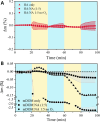Photooxidation of Nonanoic Acid by Molecular and Complex Environmental Photosensitizers
- PMID: 39498797
- PMCID: PMC11571206
- DOI: 10.1021/acs.jpca.4c05608
Photooxidation of Nonanoic Acid by Molecular and Complex Environmental Photosensitizers
Abstract
Photochemical aging and photooxidation of atmospheric particles play a crucial role in both the chemical and physical processes occurring in the troposphere. In particular, the presence of organic chromophores within atmospheric aerosols can trigger photosensitized oxidation that drives the atmospheric processes in these interfaces. However, the light-induced oxidation of the surface of atmospheric aerosols, especially those enriched with organic components, remains poorly understood. Herein, we present a gravimetric and vibrational spectroscopy study aimed to investigate the photosensitized oxidation of nonanoic acid (NA), a model system of fatty acids within organic aerosols, in the presence of complex organic photosensitizers and molecular proxies. Specifically, this study shows a comparative analysis of the photosensitized reactions of thin films containing nonanoic acid and four different organic photosensitizers, namely marine dissolved organic matter (m-DOM) and humic acids (HA) as environmental photosensitizers, and 4-imidazolecarboxaldehyde (4IC) and 4-benzoylbenzoic acid (4BBA) as molecular proxies. All reactions show predominant photooxidation of nonanoic acid, with important differences in the rate and yield of product formation depending on the photosensitizer. Limited changes were observed in the organic photosensitizer itself. Results show that, among the photosensitizers examined, 4BBA is the most effective in photooxidizing nonanoic acid. Overall, this work underscores the role of chromophores in the photooxidation of organic thin films and the relevance of such reactions on the surface of aerosols in the marine environment.
Conflict of interest statement
The authors declare no competing financial interest.
Figures








Similar articles
-
Photosensitized Formation of Secondary Organic Aerosols above the Air/Water Interface.Environ Sci Technol. 2016 Aug 16;50(16):8678-86. doi: 10.1021/acs.est.6b03520. Epub 2016 Aug 4. Environ Sci Technol. 2016. PMID: 27434860 Free PMC article.
-
Mechanistic Insights on the Photosensitized Chemistry of a Fatty Acid at the Air/Water Interface.Environ Sci Technol. 2016 Oct 18;50(20):11041-11048. doi: 10.1021/acs.est.6b03165. Epub 2016 Sep 26. Environ Sci Technol. 2016. PMID: 27611489 Free PMC article.
-
Enhanced Photochemical Volatile Organic Compounds Release from Fatty Acids by Surface-Enriched Fe(III).Environ Sci Technol. 2020 Nov 3;54(21):13448-13457. doi: 10.1021/acs.est.0c03793. Epub 2020 Oct 21. Environ Sci Technol. 2020. PMID: 33081467
-
Cellular and Acellular Assays for Measuring Oxidative Stress Induced by Ambient and Laboratory-Generated Aerosols.Res Rep Health Eff Inst. 2019 Mar;2019(197):1-57. Res Rep Health Eff Inst. 2019. PMID: 31872749 Free PMC article.
-
Formation and evolution of aqueous organic aerosols via concurrent condensation and chemical aging.Adv Colloid Interface Sci. 2019 Mar;265:45-67. doi: 10.1016/j.cis.2019.01.001. Epub 2019 Jan 14. Adv Colloid Interface Sci. 2019. PMID: 30711797 Review.
Cited by
-
Probing O(3P) Reactivity with Chemisorbed Hydrocarbons: Insights from Experiment and Theory.J Phys Chem A. 2025 Jul 10;129(27):6094-6106. doi: 10.1021/acs.jpca.5c01709. Epub 2025 Jun 3. J Phys Chem A. 2025. PMID: 40459547 Free PMC article.
References
-
- Trueblood J. V.; Wang X.; Or V. W.; Alves M. R.; Santander M. V.; Prather K. A.; Grassian V. H. The Old and the New: Aging of Sea Spray Aerosol and Formation of Secondary Marine Aerosol through OH Oxidation Reactions. ACS Earth Space Chem. 2019, 3, 2307–2314. 10.1021/acsearthspacechem.9b00087. - DOI
-
- Navea J. G.; Grassian V. H.. Photochemistry of Atmospheric Particles. In Encyclopedia of Interfacial Chemistry: Surface Science and Electrochemistry; Wandelt K.; Kolasinski K., Eds.; Elsevier Publishing: Amsterdam, 2018; pp 553–562.
-
- Leonardi A.; Ricker H. M.; Gale A. G.; Ball B. T.; Odbadrakh T. T.; Shields G. C.; Navea J. G. Particle Formation and Surface Processes on Atmospheric Aerosols: A Review of Applied Quantum Chemical Calculations. Int. J. Quantum Chem. 2020, 120, e2635010.1002/qua.26350. - DOI
LinkOut - more resources
Full Text Sources

